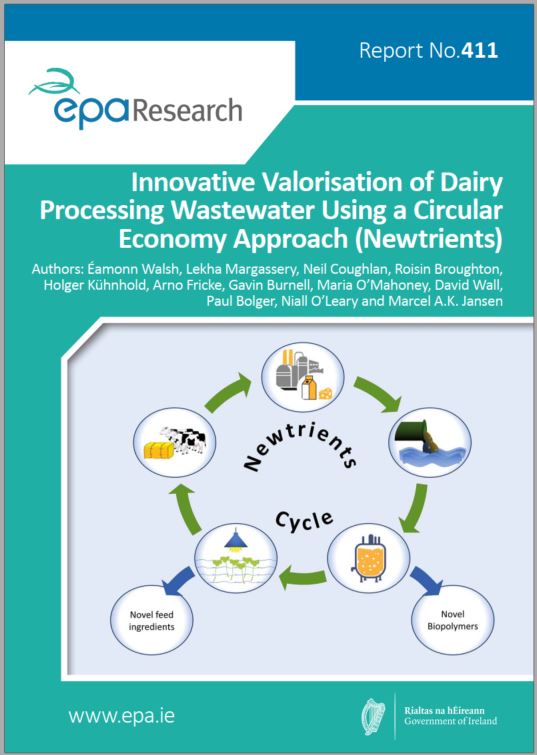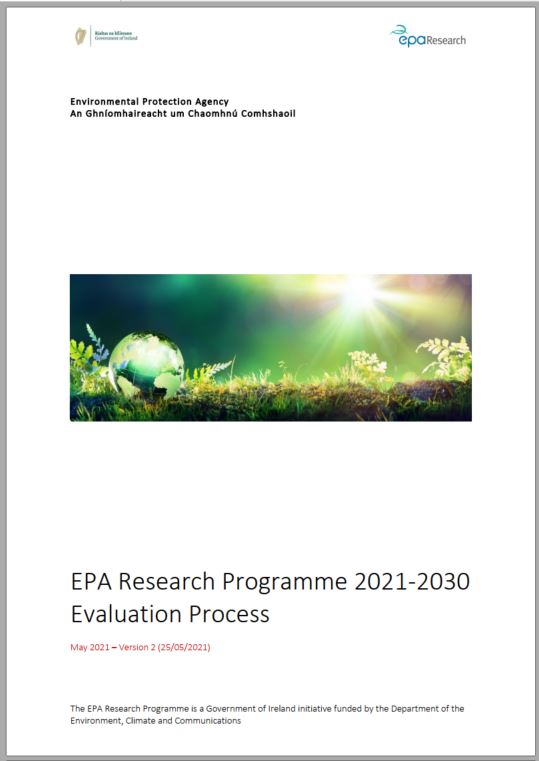Latest Research Publications

Research 413: The Diversity and Resilience of Kelp Ecosystems in Ireland
Authors: Kathryn Schoenrock, Stacy Krueger-Hadfield, Kenan Chan, Rory O’Callaghan, Tony O’Callaghan, Aaron Golden and Anne Marie Power, July 2022
Year: 2022
In Ireland, Kelp forests can be found along rocky shorelines and dominates rocky substrata along the Irish coastline (approximately 3010 km out of the 7524 km of national shoreline). The report makes recommendations concerning monitoring and preserving kelp ecosystems nationwide. A range of resilience metrics was assessed for subtidal kelp forests in Ireland to better understand how to monitor, manage and simply understand these systems and their potential responses to climate shifts in nearshore ecosystems.

Research 412: Emissions from and Fuel Consumption Associated with Off-road Vehicles and Other Machinery
Authors: Rita Hagan, Emma Markey, Jerry Clancy, Mark Keating, Aoife Donnelly, David O’Connor, Liam Morrison and Eoin McGillicuddy, July 2022
Year: 2022
Non-road mobile machinery (NRMM) is a large category that until recently had not been widely researched in terms of its contribution of exhaust emissions to overall air pollution. The emissions from NRMM contribute significantly to air pollution. To lower emissions from NRMM and improve air quality, it is recommended that more data are collected from sectors such as rail, construction, and aviation, and from Transport Infrastructure Ireland. This research used the bottom-up approach of contacting NRMM owners and data holders to request data about their NRMM fleet and its fuel use.
Green Enterprise 2022 call flyer
Year: 2022


Evidence Synthesis Report 1: A Signpost for Soil Policy in Ireland
Authors: Maria McNamara, Hannah Binner, Eric Hynes and Luisa Andrade, June 2022
Year: 2022
This study aimed to generate an accessible evidence base to support the development of new policy on soil and to enable Ireland to meet its commitments to both national and EU soil strategies.
Evidence Synthesis Report 1: A Signpost for Soil Policy in Ireland Infographic
Authors: Maria McNamara, Hannah Binner, Eric Hynes and Luisa Andrade, June 2022
Year: 2022
This study aimed to generate an accessible evidence base to support the development of new policy on soil and to enable Ireland to meet its commitments to both national and EU soil strategies.

Research 411: Innovative Valorisation of Dairy Processing Wastewater Using a Circular Economy Approach (Newtrients)
Authors: Éamonn Walsh, Lekha Margassery, Neil Coughlan, Roisin Broughton, Holger Kühnhold, Arno Fricke, Gavin Burnell, Maria O’Mahoney, David Wall, Paul Bolger, Niall O’Leary and Marcel A.K. Jansen, June 2022
Year: 2022
There are pressing economic and environmental concerns regarding the imbalance between resource consumption and regeneration. This research successfully demonstrated a paradigm shift in how wastewater is treated by developing a pioneering cascading system for valorisation of dairy wastewater, based on circular economy principles. It successfully developed an integrated system coupling microbial-based technologies of anaerobic digestion and aerobic dynamic feeding with duckweed cultivation.

Research 410: Food Loss and Waste from Farming, Fishing and Aquaculture in Ireland
Authors: Jennifer Attard and Tracey O’Connor, June 2022
Year: 2022
Food waste in Ireland has been estimated at 1.1 million tonnes per year, but this excluded farming, fishing and aquaculture (i.e. primary production), as there were no data on these sectors. This research has quantified and understood food waste in primary production and is a starting point in identifying areas that need addressing. The project has compiled various options for solutions available to tackle the specific food waste issues occurring in Ireland.

Research 409: Co-designing for Resilience in Rural Development through Peer-to-peer Learning Networks and STEAM Place-based Learning Interventions
Authors: Anita McKeown, Lucy Hunt, James Murphy, Eleanor Turner and Rebecca White, May 2022
Year: 2022
The United Nations 17 Sustainable Development Goals (SDGs) and the 2030 Agenda for Sustainable Development require governments to take ownership and establish frameworks for the achievement of the 17 global goals. Ireland has mapped existing policies and programmes against each of the 169 SDG sub targets, setting out a roadmap for achieving the goals. CoDesRes developed and explored a series of proof-of-concept methods and from this created two toolkits. As interventions, the toolkits (community peer-to-peer learning and place-based STEAM education) localise the implementation of the SDGs and offer insights into adaptive opportunities to engage the public.

EPA Research Programme 2021-2030 Fast-track to Policy Funding: Supporting policy development for ‘out of season’ bathing in Ireland.
Call 2022-02, May 2022
Year: 2022



Research 408: Sustainable Production and Consumption: The Influence of Social Norms
Authors: Gideon Fadiran and Stephen Onakuse, May 2022
Year: 2022
Consumer behaviour represents acts or decisions that influence the direction of production and consumption activities, which are, in turn, driven by household and, ultimately, economic activities. This research investigated the linkages between habits and norms that drive behavioural attitudes and preferences, and how consumers’ socio-economic background, community, beliefs, etc. are identified as the driving factors of consumer behaviour and waste patterns.

Research 407: Residential Solid Fuel Use in Ireland and the Transition Away from Solid Fuels
Authors: John Eakins, Bernadette Power, Niall Dunphy and Gordon Sirr, April 2022
Year: 2022
The EPA has highlighted air quality issues in urban centres in Ireland in recent years. Emissions of fine particulate matter (PM2.5), attributable to the burning of solid fuels, such as coal, peat and wood, are a particular cause of concern. This research project aims to provide a deeper understanding of the sector using existing and new sources of data on solid fuel use. The development of a new data set based on a survey of household heating and fuel use will be the primary contribution.

EPA Research Call 2022
Year: 2022




